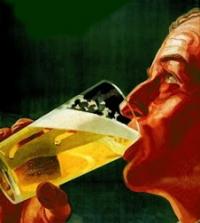
Natural Keg Carbonation
#21

Posted 03 November 2011 - 04:58 PM
#22

Posted 03 November 2011 - 05:05 PM
#23

Posted 03 November 2011 - 05:07 PM
#24

Posted 03 November 2011 - 05:38 PM
Edited by SchwanzBrewer, 03 November 2011 - 05:40 PM.
#25

Posted 03 November 2011 - 05:43 PM
Exactly -- the beer in the conditioning tank is under pressure, so some CO2 does dissolve into it, but at least half (probably more) of the carbonation comes from priming.Just to be clear, you are not carbonating in the conditioning tank, just conditioning (but it is under a bit of pressure - so it does carbonate lightly), then you are carbonating with the priming solution?
#26

Posted 04 November 2011 - 06:08 AM
have you ever done or heard of someone doing a blind taste test to prove this out?Just woke up and was directed to this thread by SchwanzBrewer. Everything we package, bottle or keg, gets primed or krausened. Why? Besides the obvious, natural carbonation, we find that our beers taste better with that secondary fermentation in the bottle or keg. It's kind of hard to explain, but the flavors kind of meld together better, giving the beer more character or smoothness or . . . like I said, it's kind of hard to put in words, but quite noticeable. Yes, force carbonating would be easier to do and easier to control, but we're not out for ease, we try to make the best beers we can. End of lecture.
#27

Posted 04 November 2011 - 06:38 AM
#28

Posted 04 November 2011 - 07:02 AM
primed beers will be a touch drier, which (IMO) is what people tend to 'like better' about naturally carbed beers. Also, getting the yeast active again can scrub out any O2 that may have been picked up in transfers.What is the benefit to naturally carbonating in a keg? Genuine question since in my understanding, force carbonating removes a lot of the downfalls of natural carbonation like yeast sediment and predictability in carbonation level. I can't really think of a benefit...
#29

Posted 04 November 2011 - 07:54 AM
#30

Posted 04 November 2011 - 08:03 AM
do you make 10 gal batches? could you split one in half for a comparison?I am going to try this on my next batch. My kegs typicaly sit aroudn for a while before I am ready to drink them so I see no reason why this would not work OK for me.
#31

Posted 04 November 2011 - 08:42 AM
yes, I do 10g batches and I could split them and send them off for a taste test.do you make 10 gal batches? could you split one in half for a comparison?
#32

Posted 05 November 2011 - 06:43 AM
#33

Posted 05 November 2011 - 09:58 AM
it;s fine to add some dry yeast with the sugar as well, if you don;t think the yeast from fermentation won't be able to handle it.How long after fermentation can you add sugar and still have active yeast to eat it? Is there ever a problem with adding sugar and then no fermentation takes place?
#34

Posted 05 November 2011 - 12:55 PM
#35

Posted 05 November 2011 - 11:59 PM
I naturally carbonate my Dirty Sanchez' Mexi Lager..... 2ndary occurs in a 10g cornie...... When its time to xfer(to 2 x 5g conries) for 2nd D- rest/ lagering... Its carbonated..... After lagering for 30-45 days its the clearest beer I've ever made. I think it benefits from the natural carbonation.... Hell, I'd do the puter screen challenge with KenLenard..... and THAT is a bold statement....Some other breweries package the beer a few points above terminal gravity so it finishes under pressure. Cheers,Rich
#36

Posted 06 November 2011 - 12:33 PM
Oh, cut it out.Hell, I'd do the puter screen challenge with KenLenard..... and THAT is a bold statement....
#37

Posted 06 November 2011 - 12:53 PM
The hefeweizen I primed yesterday used dextrose (I think?) from the LHBS. I used CJ's method to calculate the weight needed (I had 2.5 gallons not 5). I'm gonna try it with the G-MLPA next weekend too. Cheers,RichOh, cut it out.
Hey, so how many of you have racked 5 gallons of flat beer into a keg and added priming solution to naturally carb the keg? I know I posted earlier that I had heard 1/3rd cup for a 5-gallon keg but I have never tried this. I happen to have one-too-many kegs (I have 8 but can only keep 7 cold) so I thought it would be a good experiment to take that last keg (which is now empty), rack a beer to it and naturally carb it at basement temps. Is 1/3rd cup a good amount? Also, do certain styles benefit from this more than others? In secondary, I currently have an American Wheat, a Raspberry Ale, a Red Lager, A Czech Pils, an ESB, a Festbier of sorts and I have another Festbier of sorts and another ESB in primary. I'd like to try this and see how it comes out. When I was a bottler, I spoke with a number of other brewers and the overwhelming consensus was that they preferred force-carbed beers better than sugar-primed beers. Also, are you guys using plain-old corn sugar (priming sugar from the LHBS) or DME to do the priming? Cheers!
#38

Posted 06 November 2011 - 04:03 PM
I drank a lot of cask conditioned Lagers in Germany when I was there last. You need to know the days and the times they tap them at a lot of the Munich beer halls, but they are common (look for the signs that read "vom Faß"). A couple weeks ago I had a cask conditioned Märzen at a local pub. If you don't insist on high carbonation, they can be quite enjoyable. I love cask ale, but I've always assumed that the magic is really in the low level of carbonation, not the carbonation method. German casks are usually carbonated much higher than British casks, but most of the carbonation gets knocked out by the way they serve it. Anyway, all that was to say that the Festbier could be interesting, even if it is more commonly associated with a Bitter. I don't think it should matter if you carbonate with DME, corn sugar or table sugar. I use table sugar and it works just fine. Primarily, Germans use wort just because the Reinheitsgebot is interpreted to exclude the addition of refined sugar.When I was a bottler, I spoke with a number of other brewers and the overwhelming consensus was that they preferred force-carbed beers better than sugar-primed beers. Also, are you guys using plain-old corn sugar (priming sugar from the LHBS) or DME to do the priming? Cheers!
#39

Posted 06 November 2011 - 04:27 PM
DME doesn't ferment out as clean. The yeast utilize 100% of the simple sugars (or so I've been told/read)I drank a lot of cask conditioned Lagers in Germany when I was there last. You need to know the days and the times they tap them at a lot of the Munich beer halls, but they are common (look for the signs that read "vom Faß"). A couple weeks ago I had a cask conditioned Märzen at a local pub. If you don't insist on high carbonation, they can be quite enjoyable. I love cask ale, but I've always assumed that the magic is really in the low level of carbonation, not the carbonation method. German casks are usually carbonated much higher than British casks, but most of the carbonation gets knocked out by the way they serve it. Anyway, all that was to say that the Festbier could be interesting, even if it is more commonly associated with a Bitter. I don't think it should matter if you carbonate with DME, corn sugar or table sugar. I use table sugar and it works just fine. Primarily, Germans use wort just because the Reinheitsgebot is interpreted to exclude the addition of refined sugar.
#40

Posted 06 November 2011 - 04:51 PM
1 user(s) are reading this topic
0 members, 1 guests, 0 anonymous users














